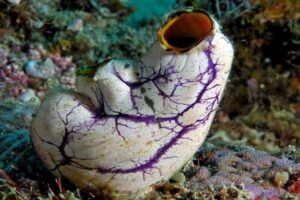
The Urochordata, commonly known as “sea squirts,” were initially considered sponges but later found their place among chordates. Lamarck, in 1816, positioned Tunicata between Radiata and Vermes in his classification, and subsequent debates led to their inclusion in Mollusca before Kowalevsky finally placed them within chordates in 1866. Urochordates exhibit distinct larval and adult characteristics, with chordate features prominently seen in their larval stages.

General Features of Urochordata
1. Variation in Size and Form: Urochordates exhibit diversity in body size and shape.
2. Unsegmented Body without Tail: Their bodies lack segmentation and a tail.
3. Test Covering: The body is covered by a test formed by tunicine, giving them the name Tunicata.
4. Body Wall Structure: The body wall comprises a one-layered epidermis, connective tissue-derived dermis, muscles, and atrial epithelium.
5. Absence of Coelom: Urochordates lack a true coelom.
6. Atrial Cavity and Aperture: The atrial cavity surrounds the pharynx, connecting to the exterior through the atrial aperture.
7. Notochord in Larvae: Larvae possess a notochord in the tail, which disappears during metamorphosis.
8. Respiratory System: Gills in the pharyngeal wall facilitate respiration.
9. Feeding Mechanism: The ciliary mode of feeding is common among urochordates.
10. Open Circulatory System: They possess an open circulatory system with a ventral heart that periodically reverses its function.
11. Nervous System: The nervous system is represented by a single dorsal ganglion in adults.
12. Excretion: Nephrocytes are responsible for excretion.
13. Asexual Reproduction: Asexual reproduction occurs through budding.
14. Bisexuality and Cross-Fertilization: Urochordates are bisexual, and cross-fertilization is favored.
15. External Fertilization: Fertilization takes place externally.
Classification of Urochordata
Class 1: Ascidiacea
- Sedentary tunicates with a test covering.
- Pharynx contains gill slits.
- Absence of the notochord, nerve cord, and tail in adults.
- Examples include Ascidia and Ciona (Order: Enterogona) and Herdmania and Botryllus (Order: Pleurogona).
Class 2: Thaliacea
- Free-swimming, pelagic urochordates with a transparent test.
- Brachial and atrial apertures at the anterior and posterior ends.
- Absence of the notochord, nerve cord, and tail in adults.
- Asexual reproduction occurs through budding.
- Alternations in generations can be observed in life history.
- Divided into Doliolida (e.g., Doliolum), Pyrosomida (colonial forms), and Salpida (e.g., Salpa).
Class 3: Larvacea (Appendicularia)
- Free-swimming pelagic tunicates lack a true test.
- The gelatinous house aids in filter feeding.
- Two-gill slits are present, and the atrium is absent.
- The notochord and nerve cord persist throughout life.
- Neotenic forms, including Oikopleura, are part of this class.
In summary, Urochordates, or sea squirts, exhibit a fascinating blend of chordate characteristics, with distinct larval and adult stages. Their classification into Ascidiacea, Thaliacea, and Larvacea highlights the diversity within this group of marine organisms.




